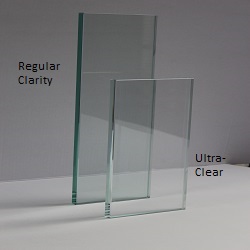The Flaws of Glass Can be Engineered Around — Acrylic’s Flaws Cannot
Acrylic is often preferred over glass because it’s lightweight, cheaper to produce, and can take on different shapes.
We argue that, while these factors are important to the manufacturer and the customer, glass fish tanks offer more durability, clarity, and longevity than acrylic ones.
See the chart below for a more in-depth comparison of glass and acrylic tanks.
Why We Prefer Glass to Acrylic
Overall, we prefer glass to acrylic. We find that acrylic tanks sacrifice long-term durability for short-term looks.
Now, glass isn’t perfect, but we mitigate the disadvantages of glass aquariums through our fabrication, moving techniques, and ultra-clear material options.
Read further for more glass-acrylic comparisons!

Acrylic Aquariums Scratch Easily
Acrylic is a type of plastic, and regardless of the “acrylic-friendly” scrubbers you use, all it takes is one mishap to have scratches all over. Glass aquariums can scratch, but they have a much higher resistance.
You can buff acrylic scratches, but you’ll have to drain your whole fish tank, you may introduce harmful chemicals/buffing compounds, and it will still be difficult to restore its original clarity.
Acrylic Aquariums Are Prone to Fabrication Flaws
Since acrylic is flexible and non-rigid, the tank’s design and welding quality are critical to its integrity; much more so than rigid glass aquarium panels.
When welding the joints of an acrylic tank, even the slightest oversight can lead to air bubbles, comprising the integrity of the whole tank.
Over time, it’s far less probable that a glass aquarium fails than an acrylic one. Glass panels are rigid, so the joints are much stronger and more forgiving than acrylic.
Acrylic Aquariums Become Yellow and Brittle
A major flaw of acrylic is it turns yellow over time due to UV light. Many plastic materials claim to be “UV Resistant”, but no acrylic is UV-proof, and no additives can make plastic/acrylic stand up to UV light as long as glass.
Continuous UV light from the sun or aquarium lights can also become brittle, crack, and fail. The more UV lights you have on your tank, or the closer it is to a window, the more accelerated this process will be.
Acrylic Aquariums Have Porous Material
Many people don’t consider acrylic a porous material because there are acrylic water containers. But even though water doesn’t visibly pass through acrylic, it is still absorbed and slowly leaches out the other side.
The chemicals and bacteria in the tank or the outside air may deteriorate the acrylic and fester at the microscopic level.
Like a plastic container that’s sat outside for years… UV light takes its toll, and the chemical elements are impregnated in the material, changing its composition forever. Meanwhile, a glass pane can endure the elements for generations and come back to nearly its original condition after a good cleaning.
Acrylic Aquariums Have More Visible Distortion
First off, acrylic clarity can vary a lot depending on the grade and brand used by the manufacturer.
Second, acrylic panels are flexible and can bow in the middle, creating visible distortions. Large acrylic fish tanks require thick, expensive panels to prevent this. Even so, acrylic this thick is often prone to impurities, making it less clear.
Third, the strength of an acrylic aquarium relies heavily on the weld rather than the panel’s rigidity. Much of the strength and potential distortion is placed on the weld, making human error a more significant factor.
Glass aquariums, on the other hand, are very rigid and come from the factory perfectly flat with tight manufacturing tolerances. We also offer a low-iron, Ultra-clear glass option to improve the optical clarity of the fish tank.
